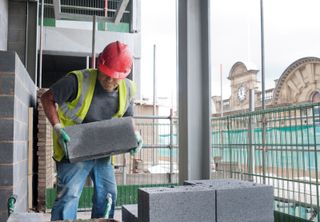Building materials prices fall annually in August by 2.3% despite shortages
Building materials prices fall for the third consecutive month despite suffering shortages in key products as output across the sector falls

Building materials prices fell in August by 2.3%, showing consecutive months of declining prices, according to government figures.
This news follows an annual 4% drop in prices in July, with the decline largely explained by an overall decline in homebuilding figures.
However, despite the decline in prices, key materials have seen significant shortages such as bricks and blocks, contributing to declining output across the construction industry.
Here we take a look at the latest updates and statistics to see how it might affecthow much it costs to build a house.
Building materials costs rise while availability declines
There has been a 3.7% year-on-year decline in construction costs, as the market is showing signs of recovery, despite declining product availability and rising inflation, according to theBuilding Materials and Components Statisticsfor August.
After analysing the year-on-year changes, the cost of all estimated construction work fell by 2.3% from August 2022 to August 2023, while repair and renovation work in particular falling by 2.8%.
However, there has been widespread decline in sales of materials across the sector, despite the decline in prices, largely due to a decline in availability.
Sales of sand & gravel decreased by 2.5% in Quarter 2 2023 compared to Quarter 1 2023. This is true of ready-mixed concrete sales, which decreased by 0.8% in Quarter 2 2023 compared to Quarter 1 2023.
Although, brick and block deliveries were by far the most impacted though with year-on-year falls in August of 16.2% for blocks and a staggering 30% decline in brick deliveries.
Construction materials experiencing the greatest price increases and decreases in the 12 months to August 2023, UK
Greatest price increases
- Screws etc. +25.3%
- Doors & windows (metal) +20.4%
- Ready-mixed concrete +20.1%
Greatest price decreases
- Fabricated structural steel -29.3%
- Concrete reinforcing bars -28.0%
- Imported, sawn, or planed wood -19.2%
Forterra, the largest brickmaker in the UK, put out a statement last month stating its profit predictions for 2023 were "overoptimistic" with reported revenue for the first half of 2023 predicted to be £183m, a decrease of 18% compared with 2022.
Forterra suggested production decisions would be influenced by demand with the company scaling back production as it reacts to the slowdown in housebuilding.
However, according to John Newcomb, CEO of the Builders Merchants Federation, and Peter Caplehorn, CEO of the Construction Products Association, Co-Chairs of theConstruction Leadership's (CLC's) Product Availabilityworking group the introduction of new brick manufacturing plants in the UK over the next 6-12 months will significantly reduce the country's reliance on expensive imports to replenish stocks in the future.

They also claim that the latest material prices and availability simply show that the products have "returned to pre-covid levels" and the price reductions can be explained by a "sharp fall in house building over the past year" and price inflation "stabilising".
They added: "Whereas a year ago we were seeing increases of over 5%, if products are increasing in price, it is now at 1-2%. There are reports of more discounts in the market and some indicators show prices coming down. The price of timber, for example, continues to fall, along with some plastic and energy intensive products.
"This is largely due to a stagnation of demand, particularly the ongoing decline in housebuilding activity over the last six months. Poor weather and strikes in July and the August holiday period also contributed to a slowdown in activity over the summer.
"Although there are signs of improvement in some regions in September, the key economic drivers – inflation, increased cost of living and higher interest rates – will remain a significant challenge for construction output for the rest of the year."
Construction sector set for uncertain future
For even more advice, information and inspiration delivered straight to your door,subscribe toHomebuilding & Renovatingmagazine.
The Building Materials statistics estimate monthly construction output increased by 1.6% in July.
One of the main contributors for this increase was rises in both new work (2.0%) and repair and maintenance (1.1%).
Construction output volumes were also revealed to have fallen due to a decline in demand for houses in the Bank of England's (BoE)Agents’ Summary of Business Conditionsfor Q3 of 2023.
This revealed that homebuilders slowed down new site openings and existing construction due to weakening demand and home renovation projects also reduced because of relatively high material costs.
It is predicted by the BoE that the construction sector will face further declines in activity in the next six months due to weaker demand and delayed projects, with costs remaining high.
How else could your project be affected?
Despite material prices falling government and expert predictions for the market suggest the future of the homebuilding sector could be in turmoil for those looking to start new projects.
As well as a shortage of product availability for key materials there are a number of issues affecting the construction sector such as worker shortages and rising wages.
这也是由建筑材料和预测Components analysis that the rest of the year is expected to be tougher for the industry, particularly in the housing sector, both for new construction and renovation works.
In 2023, total construction output is predicted to decrease by 4.4%, falling below the pre-pandemic level of 2019.
In the private housing sector, there are signs of a cooling housing market as new inquiries decrease andhouse pricesdrop and the housing sector is anticipated to face a sharp decline of 14.9% in 2023, but is projected to recover with a 5.5% increase in 2024 and a 7.0% increase in 2025.
Additionally, government support programs have been scaled back, and economic uncertainties are discouraging private housebuilders from taking on new construction projects with "enthusiasm".

Common challenges for both private and public housing sectors include relatively high material prices and labour shortages, which are likely to disrupt construction plans and cause delays in the short term, albeit temporarily.
In mid-July 2023, 19.6% of construction businesses that had not permanently ceased operations were facing worker shortages, while the remaining 54.1% were not experiencing any shortages of workers.
There is a reported lack of skilled workers in the sector after anElectricalDirectstudy of 500 builders and tradespeople revealed a key concern among 25% of builders was the lack of skilled workers in their sectors. This is corroborated by the ONS who reported that 25% of construction businesses in the UK were experiencing skilled labour shortages.
大约有244000工人少construction sector compared to three years ago, the ONS says, attributable to workers returning to the EU and early retirees. And this shortage is particularly affecting SME (small and medium-sized enterprises) builders since it can take a minimum of three years to train up a skilled tradesperson.

Need more advice or inspiration for your project? Get two free tickets to theHomebuilding & Renovating Show
TheFederation of Master Builders(FMB) also reported difficulties in hiring skilled bricklayers and carpenters, and the shortage is seen as a factor in the rising cost of construction and wage increases, making it challenging for companies to remain competitive.
The construction industry also faces obstacles in the planning process, with calls for increased funding to local authority planning departments and a simplified planning process.
Tim Balcon, CEO of the Construction Industry Training Board (CITB), claimed: "The greatest challenge UK construction faces over the next five years is recruiting the number of people required to fill the growing number of vacancies."
How to navigate price fluctuations
If you’re planning or in the middle of building work, then planning as far as you can in advance is pivotal to ensure you aren’t caught out by price rises.
The CLC advises self builders to work closely with their supply chain and communicate your requirements early with suppliers, distributors and builders merchants.
Builder and Homebuilding & Renovating Show speaker and expert Andy Stevens offers the following advice: "There will be material price rises so you need to work closely with your builder and budget for these.
"It’s so hard to predict accurately because of the volatility of the market, but make sure you work closely with your builder as we are in the merchants all the time and hear about price changes before anyone."

Andy Stevens, an award-winning builder and owner of Surrey's Eclipse Property Solutions, specialises in new builds, extensions, and loft conversions. Apart from hands-on work, he's an active figure in the construction sector serving on the Board of the Federation of Master Builders and was formerly Vice President. He also supports construction-related charities and advocates for mental health awareness within the industry.
Get the Homebuilding & Renovating Newsletter
Bring your dream home to life with expert advice, how-to guides and design inspiration, direct to your inbox.

News Editor Joseph has previously written for Today’s Media and Chambers & Partners, focusing on news for conveyancers and industry professionals. Joseph has just started his own self build project, building his own home on his family’s farm with planning permission for a timber frame, three-bedroom house in a one-acre field. The foundation work has already begun and he hopes to have the home built in the next year. Prior to this he renovated his family's home as well as doing several DIY projects, including installing a shower, building sheds, and livestock fences and shelters for the farm’s animals. Outside of homebuilding, Joseph loves rugby and has written for Rugby World, the world’s largest rugby magazine.
- Jack WoodfieldNews Editor
Most Popular

BySam Webb

BySam Webb

BySam Webb